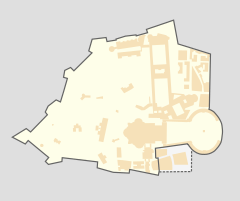Borgia Apartments facts for kids
The Borgia Apartments are a special set of rooms in the Apostolic Palace in the Vatican. They were made for Pope Alexander VI (Rodrigo de Borja) to use as his private home. In the late 1400s, he asked the Italian painter Bernardino di Betto (Pinturicchio) and his team to decorate these rooms with beautiful frescoes.
These paintings were created between 1492 and 1494. They told stories using ideas from old books and celebrated the Borgia family. Five of the six rooms have frescoes painted on their ceilings. The upper parts of the walls also have paintings, while the lower parts were decorated with tapestries and gold. A recent cleaning of Pinturicchio's fresco The Resurrection showed something amazing. It might be the first known European painting of Native Americans. This was painted just two years after Christopher Columbus returned from the New World!
The Borgia Apartments have six main rooms:
- Room of the Sibyls
- Room of the Creed
- Room of the Liberal Arts
- Room of the Saints
- Room of Mysteries
- Room of Pontiffs
The Room of Sibyls and the Room of Creed have frescoes of Old Testament prophets and sibyls. These rooms also honor the planets. In the Room of Liberal Arts, Pinturicchio painted the liberal arts as female figures on the ceiling. The Room of Saints shows frescoes detailing the lives of seven important saints. These include Barbara, Catherine, Anthony, Paul, Susanna, and Elizabeth. Pinturicchio's last room, the Room of Mysteries, has frescoes about the New Testament. These include scenes like the Nativity and the Ascension.
The Room of the Pontiffs was built first, between 1277 and 1280. The Room of the Liberal Arts, Saints, and Mysteries were built later, between 1447 and 1455. Pope Alexander VI's master of ceremonies, Johannes Burchard, called them "secret rooms." As of 2019, you can visit these amazing apartments as a tourist.
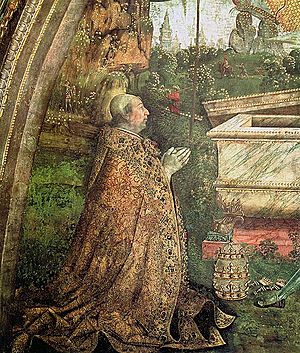
Contents
The Amazing Frescoes
After Pope Alexander VI died in 1503, his family lost power. The apartments were not used much for hundreds of years. The next pope, Julius II, left these apartments. He moved his daily work to the upper floors, which are now called the Raphael Rooms. When Julius II moved out, the Borgia Apartments started to fall apart.
The paintings were even removed in 1816, and the rooms became a library. It wasn't until 1889 that Pope Leo XIII had the rooms fixed up. He then opened them for people to see. Today, the artworks in the apartments are part of the Vatican Library.
The restoration work involved fixing the plaster and stucco. Workers also cleaned the frescoes and repaired the surfaces. Some of the lower parts of the walls had to be removed. However, you can still see some of the original decorations.
Most of these rooms now hold the Vatican Collection of Modern Religious Art. This collection was started by Pope Paul VI in 1973. It has about 600 artworks, including paintings, sculptures, and drawings. These were given by modern Italian and international artists. You can see works by famous artists like Paul Gauguin, Marc Chagall, Paul Klee, Salvador Dalí, and Wassily Kandinsky.
The upper parts of the walls and ceilings are covered with paintings. They also have delicate stucco designs. Much of the apartment's decoration might have been inspired by Annio da Viterbo. He was a humanist and a Dominican friar. Pinturicchio completed five of the rooms. Their main subjects are:
Hall of the Mysteries of Faith
| Hall of Mysteries of the Faith | |||
|---|---|---|---|
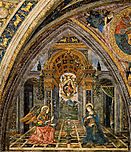 |
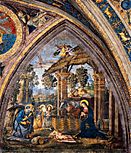 |
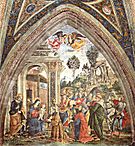 |
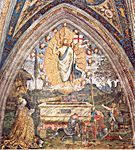 |
| Annunciation | Nativity | Adoration of the Magi | Resurrection |
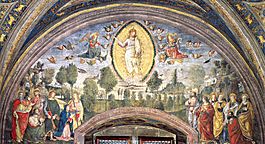 |
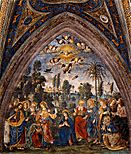 |
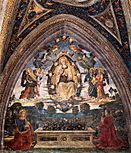 |
|
| Ascension | Descent of the Holy Spirit | Assumption of the Virgin | |
Hall of the Saints
| Hall of the Saints | ||
|---|---|---|
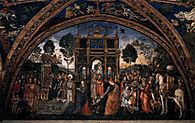 |
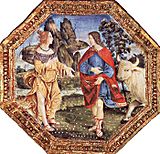 |
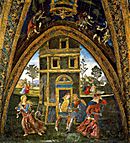 |
| St Catherine's Disputation | Myth of the Bull Apis | Martyrdom of Saint Barbara |
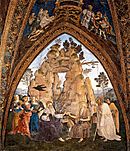 |
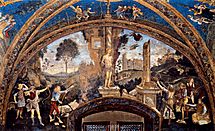 |
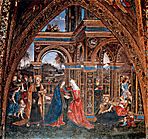 |
| Paul the Hermit | Martyrdom of Saint Sebastian | The Visitation |
Hall of the Trivium and Quadrivium
| The Arts of the Trivium and Quadrivium (selected) | ||||
|---|---|---|---|---|
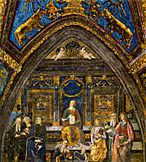 |
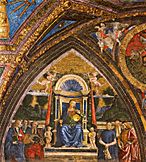 |
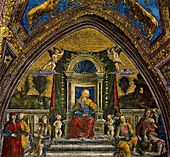 |
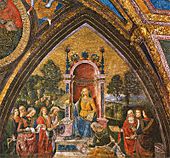 |
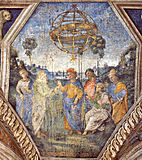 |
| Grammar (Trivium) | Rhetoric (Trivium) | Music (Quadrivium) | Geometry (Quadrivium) | Astrology (Quadrivium) |
The Room of the Sibyls
The Room of Sibyls is part of the Borgia Tower, which was built for defense. It shows twelve images of Old Testament prophets, called sibyls. Pope Alexander VI wanted the Borgia Tower to be useful. Pinturicchio showed the sibyls holding scrolls. These scrolls predicted the coming of Christ. He painted the prophets against a deep blue background.
On the ceiling, Pinturicchio painted the seven planets as Roman gods. They are pulled by chariots with animals. Each animal matches the planet's zodiac sign. The paintings show how the planets influence Earth. For example, Mercury is shown with merchants. Saturn is with charity. As a special tribute to Pope Alexander VI, Venus is pulled by bulls. The bull was the symbol of the Borgia family. Astrology was very important to many popes during the Renaissance. It is shown in detail in the Room of Sibyls.
The Room of the Creed
The Room of the Creed is also in the Borgia Tower. It looks similar to the Room of Sibyls. The frescoes in this room tell the story of the Apostle's Creed. This is a statement of beliefs with the main ideas of Christian teachings. The twelve closest followers of Christ hold scrolls with verses from the Creed. This room connects the Old and New Testament stories that the Borgia family wanted to show.
The ceiling in the Room of the Creed has geometric shapes. The paintings of the apostles in both this room and the Room of Sibyls look more formal. You can see Pinturicchio's classic style in the way the figures' robes and head-dresses are painted. The windows in the Room of the Creed also have amazing decorations. You can see natural images like fish and deer mixed with cupids and symbols of music.
The Room of Liberal Arts
The Room of Liberal Arts shows Pinturicchio's paintings of the seven Liberal Arts. These are Grammar, Rhetoric, and Logic (Trivium) and Geometry, Arithmetic, Music, and Astronomy (Quadrivium). Pinturicchio painted each of these as heavenly women. They are joined by human figures who are honoring them. For example, Cicero is with Rhetoric, and Euclid praises Geometry.
This room also has a painting of Justice on a throne. She holds a sword and a balance. Justice is shown on the arch that separates the decorated ceiling from the wall paintings. Some of the Bible stories on the walls include Jacob running from Laban. The ceiling shows the achievements and family symbol of the House of Borgia. This includes a double crown for the kingdoms of Aragon and Sicily, a red flame, an ox, and a sun.
We are not completely sure what this room was used for. However, it is often thought to be a study for important members of the Borgia family. Two smaller rooms next to the Room of Liberal Arts might have been a bedroom and a bathroom.
Art experts started a big project in the Room of Liberal Arts in 2016. They found a damaged painting of Pinturicchio's "The Resurrection." This painting showed Native Americans in Europe. Pinturicchio used dry plaster for this work, which made it easier to damage. His fingerprints and those of his helpers were found in the frescoes. His signature is under the painting of Rhetoric. It is believed that Pope Alexander VI wanted Pinturicchio to paint stories about religious origins. Many of these were from Egypt and Ancient Rome. The restorers found bright blues, reds, and greens. In the painting for Music, Pinturicchio painted musicians with Spanish influences. This was a tribute to Pope Alexander VI's home country.
The Room of Saints
The Room of Saints shows stories from the lives of seven saints from the Bible. It also has the largest and best painting of the Borgia family symbol, the bull. The seven saints are Elizabeth, Anthony, Barbara, Susanna, Sebastian, Paul, and Catherine. Pinturicchio painted famous scenes like The Visitation, showing Saint Elizabeth. He also painted Susannah and the Elders, showing Saint Sebastian. By connecting the bull to the lives of saints, Pope Alexander VI linked his rule to divine blessing.
The eight ceiling frescoes tell the story of Isis, Apis, and Osiris. This shows Pope Alexander VI's interest in ancient Egypt. The ceiling is divided into triangle shapes. The first three show Osiris's teachings. Then comes his marriage to Isis. Finally, Typhon's murder of Osiris is shown. The Room of the Saints was one of the "secret rooms" of the Borgia Apartments. It might have been a private space for the Pope.
The Room of Mysteries
The Room of Mysteries holds frescoes that show the "mysteries of faith." These paintings are thought to have influenced Raphael's Disputation of the Holy Sacrament. The Bible scenes showing these mysteries were painted to make viewers feel religious devotion. Pinturicchio's work in this room is everywhere. It was meant to be a holy lesson for people new to religious education. The figures in this room show less emotion and movement. The Room of the Mysteries includes The Annunciation, The Nativity, The Adoration of the Magi, and The Resurrection. Pope Alexander VI greatly admired the Virgin Mary. This is why many of Pinturicchio's paintings in this room were about her life. Pope Alexander VI himself is shown in The Resurrection painting, kneeling at Christ's feet.
See also
 In Spanish: Apartamentos Borgia para niños
In Spanish: Apartamentos Borgia para niños
- Index of Vatican City-related articles


